What's The Best Gtx Card
All-time Graphics Cards for Gaming in 2022
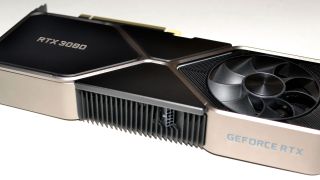
The best graphics cards are the chirapsia eye of any gaming PC, and everything else comes second. Without a stiff GPU pushing pixels, even the fastest CPU won't manage much. While no unmarried graphics card will exist right for everyone, we'll provide options for every budget and mindset. Whether yous're after the fastest graphics card, the all-time value, or the best menu at a given toll, we've got you covered.
Where our GPU benchmarks hierarchy ranks all of the cards based purely on performance, our list of the best graphics cards looks at the whole parcel. Price, availability, performance, features, and efficiency are all important, though the weighting becomes more subjective. The best news right now is that the long, dark dark of GPU shortages and horrible prices is coming to an end. Cryptocurrency mining profitability took a nosedive, and Graphics card prices dropped another 15% on average last month. All of the major GPUs are now in stock at online stores, and over half of them can exist had at or below the official MSRPs.
We at present have the Radeon RX 6950 XT, RX 6750 XT, and RX 6650 XT in our charts, forth with Nvidia'due south RTX 3090 Ti. Unfortunately, MSRPs on all 4 of those are higher than pre-existing cards, making them a questionable value. We're also still waiting for Intel Arc Alchemist to make it on desktops, which likely won't happen until July or August at earliest, while the latest Nvidia Ada rumors propose a tardily Q3 launch at best.
Notation: Prices on some of the graphics cards are yet to a higher place MSRP, simply prices have begun to drib chop-chop. Nosotros previously used boilerplate prices from eBay, since that was about the but place you could buy many GPUs. We're now able to detect every GPU at an online retailer (Amazon, Newegg, etc.), and so we're showing those prices, along with the official launch MSRPs.
Our listing at present consists entirely of current generation cards. That's because prices have inverse enough that they're the best deals available, unless y'all want to deal with ownership used cards off eBay. We sorted the above list in order of performance, considering both regular and DXR performance, which is why the RTX 3080 ranks alee of the RX 6900 XT. Our subjective rankings beneath also cistron in price, ability, and features adjusted past our ain opinions. Others may offer a slightly different take, but any of the cards on this listing are worth considering.
Best Graphics Cards for Gaming 2022
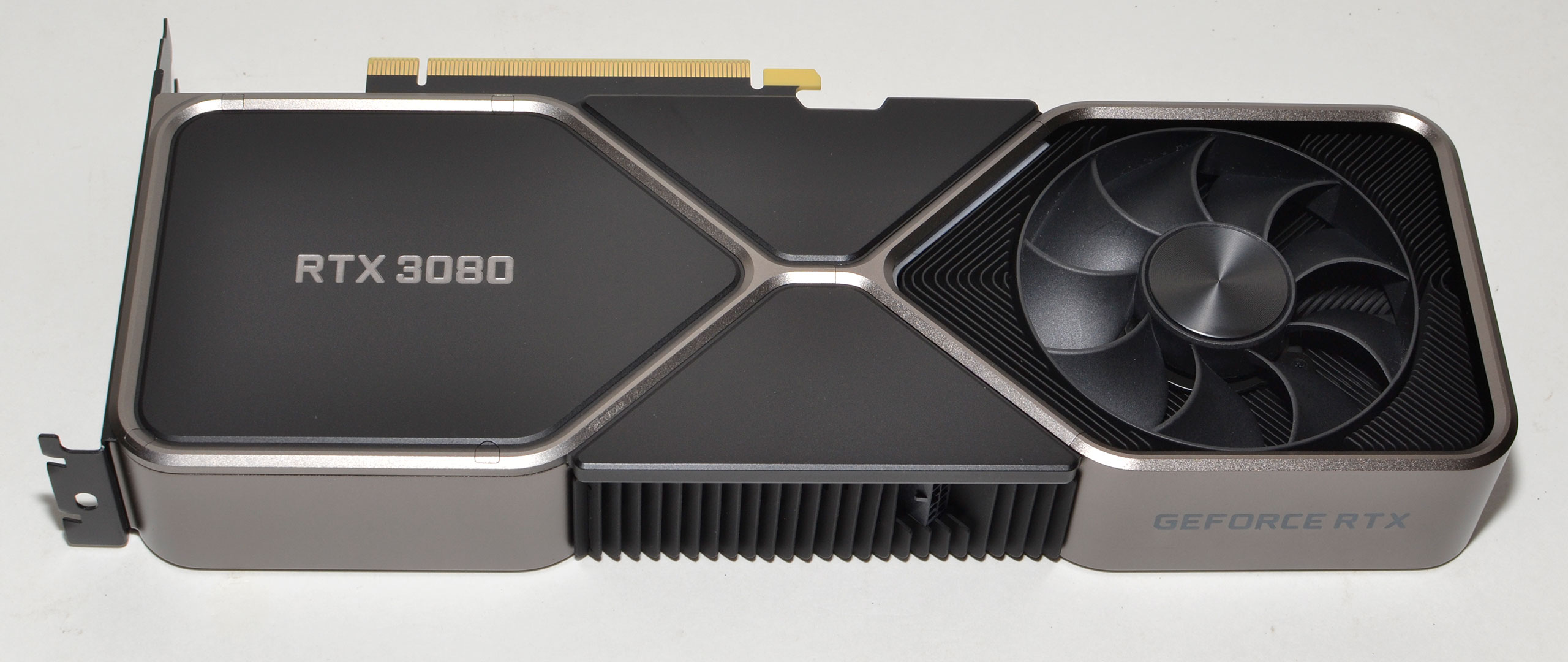
Nvidia's GeForce RTX 3080 sports Nvidia's latest Ampere architecture. It's over xxx% faster than the previous gen 2080 Ti, and supposedly costs $500 less. When we tested the new RTX 3080 Ti, information technology didn't manage to supervene upon the incumbent, thanks to its significantly higher pricing. However, do continue an eye out for the RTX 3080 12GB cards, which at present seems to behave nigh a $50 price premium — a premium well worth paying in our book.
If you're serious most maxing out all the graphics settings and you want to play at 4K or 1440p, this is the card to become. Information technology's mostly overkill for 1080p gaming, unless you're running the latest ray tracing games, in which case DLSS back up should too help operation. If yous skipped the commencement circular of RTX GPUs, the RTX 30-series might finally get you you on lath the ray tracing train. With potentially double the ray tracing performance of Turing, the RTX 3080 is your best bet at playing games in all their ray traced glory without nuking the piggy bank.
Ampere too brings improved tensor cores for DLSS, a technology that continues to proliferate among recent game releases. Nvidia's RT and DLSS performance are as well quite a bit faster than what you get from AMD's new RX 6000 cards, which is a good matter as Nvidia sometimes falls backside in traditional rasterization operation. AMD offers the universal FSR two.0 as an alternative to DLSS, only and so far information technology'due south merely in a scattering of games.
Prices on the RTX 3080 have been extremely inflated for near of the past ii years, but things are getting down to reasonable levels now. Nosotros typically can find cards for around $800, sometimes including the 12GB variant. Information technology's not necessarily the all-time value, merely this remains our all-time selection for a fast GPU right at present.
Read:
Nvidia GeForce RTX 3080 Review (opens in new tab) 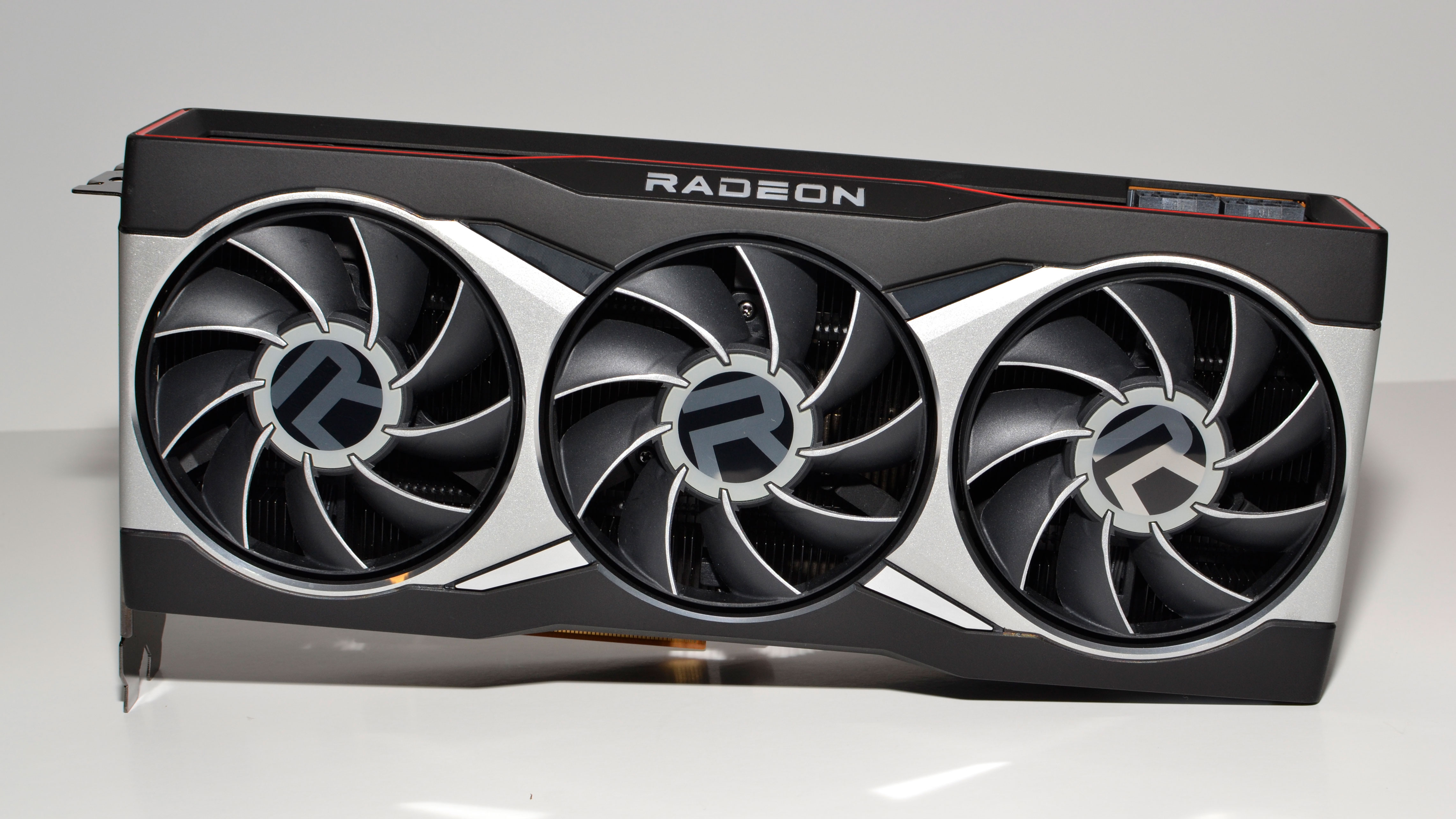
AMD's Radeon RX 6800 XT is the best card for Team Red. The RX 6800 XT provides a massive boost in functioning and features relative to the previous generation RX 5700 XT, equally well equally adding ray tracing back up (via DirectX Raytracing or VulkanRT). In our testing, the RX Radeon 6900 XT is technically about 5-vii percent faster, only it theoretically costs 54 percent more. That's not a great deal, especially since you don't get more VRAM or any other extras. Exercise pay attention to the current online prices, however, equally the 6900 merely costs about $100 extra and might be worth the spend right now.
The Navi 21 GPU was affectionately dubbed 'Large Navi' prior to launch by the enthusiast community, and we got exactly what we wanted. It'south over twice the size of the previous generation Navi x, with twice the shader cores and twice the RAM. Clock speeds are also boosted into the 2.1-2.iv GHz range (depending on the card model), and AMD did all this without essentially increasing power requirements: The RX 6800 XT has a 300W TBP, slightly lower than the RTX 3080'south 320W TBP.
A big part of AMD'southward functioning comes thank you to the massive 128MB Infinity Enshroud. Information technology improves the effective bandwidth by 119%, according to AMD. We're confident that few if whatever games in the coming years are going to need more than 16GB, then the 6800 XT is in a great position in that surface area.
What's not to like? The ray tracing operation is mediocre. Maybe it's because DXR games are more likely to be optimized for Nvidia's RTX GPUs, only overall the 6800 XT comes in slightly behind the RTX 3070 in ray tracing performance, and in that location are several games where it falls behind by up to 25%. And that's without turning on DLSS, which even in Quality mode can meliorate performance of RTX cards by 20-40% (sometimes more). AMD'due south FidelityFX Super Resolution can help, simply it's not as widely used and doesn't lucifer the quality of DLSS. FSR 2.0 helps to change that, but only three games using the tech are currently out.
Cost and availability aren't bully, but at least the RX 6800 XT can now be constitute online for nether $800. That merely about $thirty less than the RTX 3080, which we adopt thanks to its improved feature set up.
Read:
AMD Radeon RX 6800 XT Review (opens in new tab) 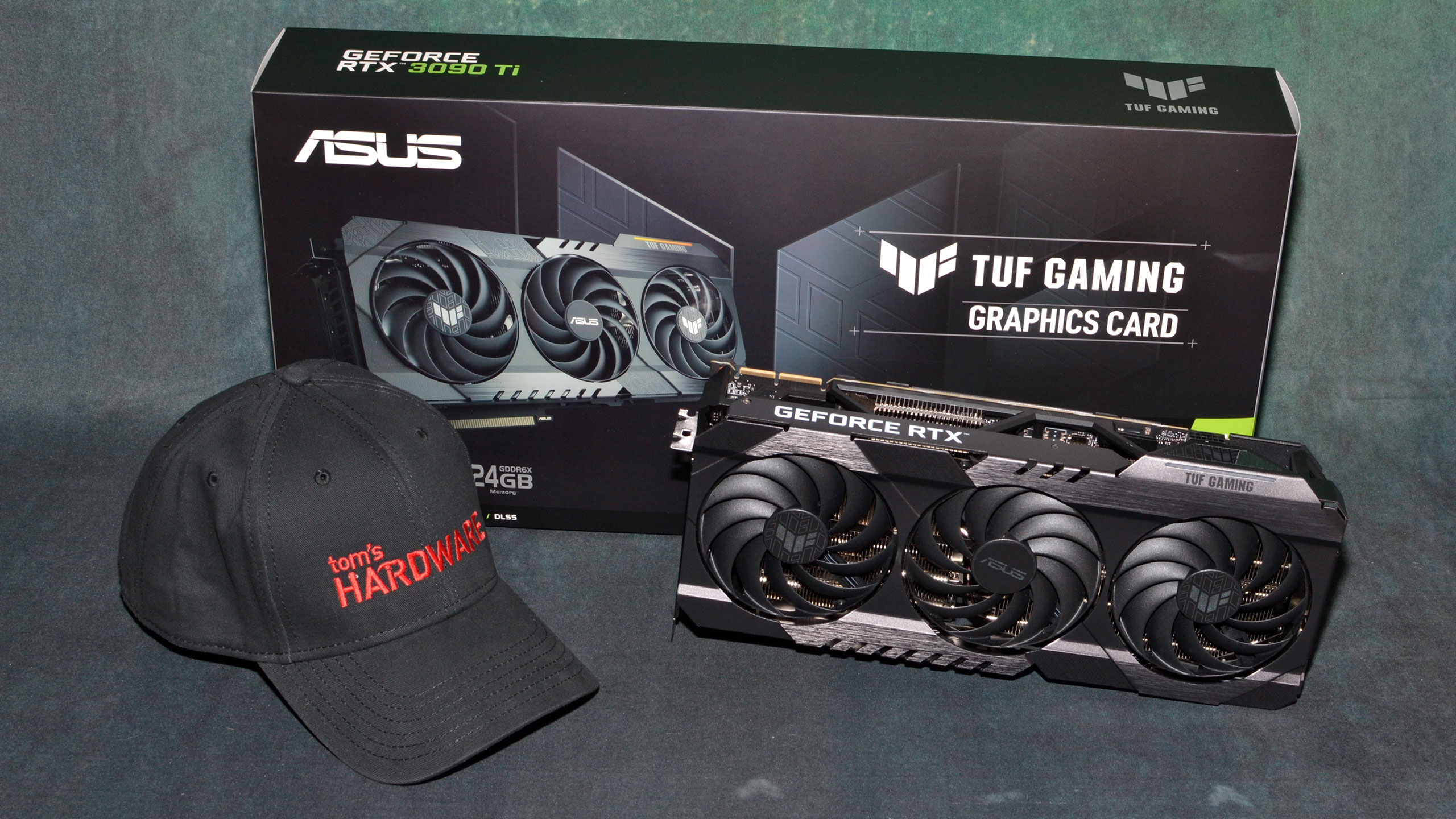
For some, the best graphics card is the fastest card, pricing be damned! Nvidia's GeForce RTX 3090 Ti caters to this category of user. At more double the official starting price of the RTX 3080, functioning is only moderately meliorate (20-30%) in most workloads. Information technology's also simply v–10% faster than the previous RTX 3090, with an even higher MSRP. Just looking at online prices, the 3090 Ti may simply price a couple hundred more than than a 3090, and who are we kidding: Anyone seriously considering either of these probably doesn't need to worry about a few Benjamins.
The RTX 3090 Ti will reign equally Nvidia's height GPU until the adjacent generation Nvidia Ada Lovelace GPUs go far. It sports a complete GA102 bit with 84 SMs, so there's no room or time for a new Titan carte. Nvidia has said as much too, that the 3090 Ti brings Titan-class operation and features (specifically the 24GB VRAM) into the GeForce brand. If you simply must have the fastest graphics card available, the RTX 3090 Ti isn't probable to exist surpassed until this fall.
It'due south not just nigh gaming, of form. The RTX 3090 Ti has NVLink support, which is arguably more useful for professional apps and GPU compute than SLI. The 24GB of GDDR6X memory is also helpful in a variety of content creation applications. Blender for example frequently showed 35% higher performance compared to the 3080, and over twice the operation of the Titan RTX. Just lookout out for lower than expected performance in some of the SPECviewperf apps, where the Titan RTX has additional features turned on in its drivers that aren't enabled for GeForce cards. (You'll need the even more expensive Nvidia RTX A6000 for the full professional person driver suite.)
AMD'southward RX 6950 XT challenges the RTX 3090 Ti in traditional rasterization performance and wins in a few SPECviewperf tests. But if yous desire the absolute fastest graphics card right now, Nvidia wins, particularly if y'all run games with ray tracing and DLSS enabled. But don't be surprised when Nvidia's next-generation farthermost GPUs arrive and make the 3090 Ti look similar lukewarm gravy.
Read:
Nvidia GeForce RTX 3090 Ti Review 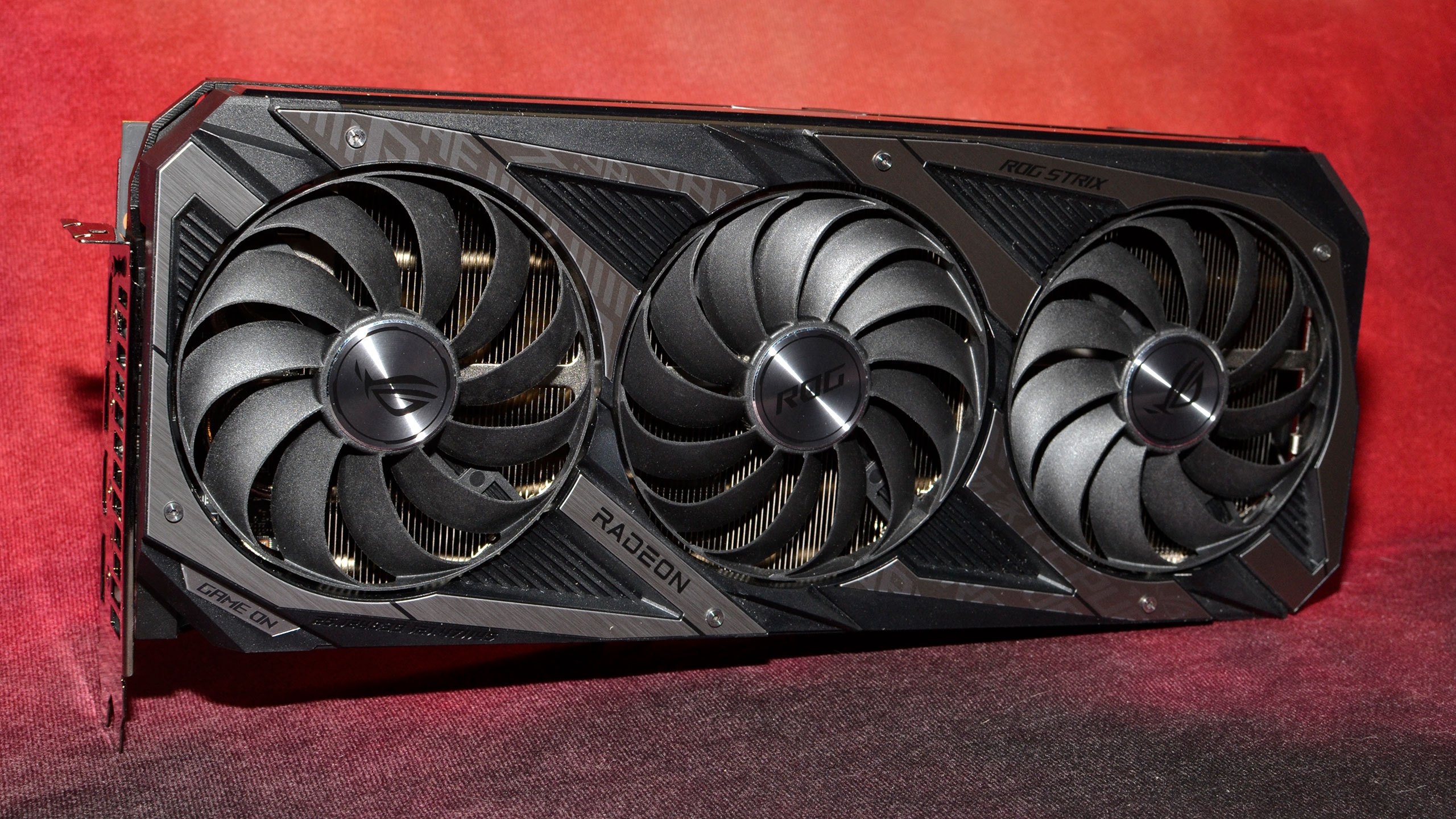
Start with the Navi 21 GPU and then cut down the various functional units to create a smaller die that can sell at lower prices and y'all accept AMD's Navi 22 and the RX 6700 XT. The RX 6750 XT is basically the same GPU, with a slight boost to clock speeds, memory speeds, and ability consumption — about v% faster overall, simply with a 10% cost hike. The 6700 XT has the aforementioned number of GPU cores every bit the previous generation RX 5700 XT, but significantly college clock speeds and more than cache give information technology virtually a 25% boost to performance (at higher settings and resolutions, at least).
When we tested AMD's RX 6700 XT, it hit clock speeds in excess of 2.5GHz during gaming sessions — and that'south at stock, on the reference carte du jour. With some tuning and overclocking, we were able to hit speeds of 2.vii-2.8GHz, however without cooking the GPU. That's very impressive, and factory overclocked cards can push fifty-fifty college clocks, though they also cost more.
In our performance testing, the RX 6700 XT traded blows with the RTX 3070 and RTX 3060 Ti. Information technology's a scrap faster than the latter, and a scrap slower than the former, and then the going price of effectually $480 is reasonable. Still, if nosotros include pretty much whatever games with DLSS or ray tracing, the 6700 XT comes in behind the 3060 Ti and almost looks similar a 3060 competitor.
This card has moved upwards in our overall rankings thanks to its first-class online prices. It's currently available at prices starting just beneath the official MSRP, and it costs about $fifty less than the cheapest RTX 3060 Ti while delivering comparable functioning. Go on an eye on the newer RX 6750 XT as well, as it could end up being a better pick if prices go on to drib.
Read: AMD Radeon RX 6700 XT review (opens in new tab)
AMD Radeon RX 6750 XT review (opens in new tab)
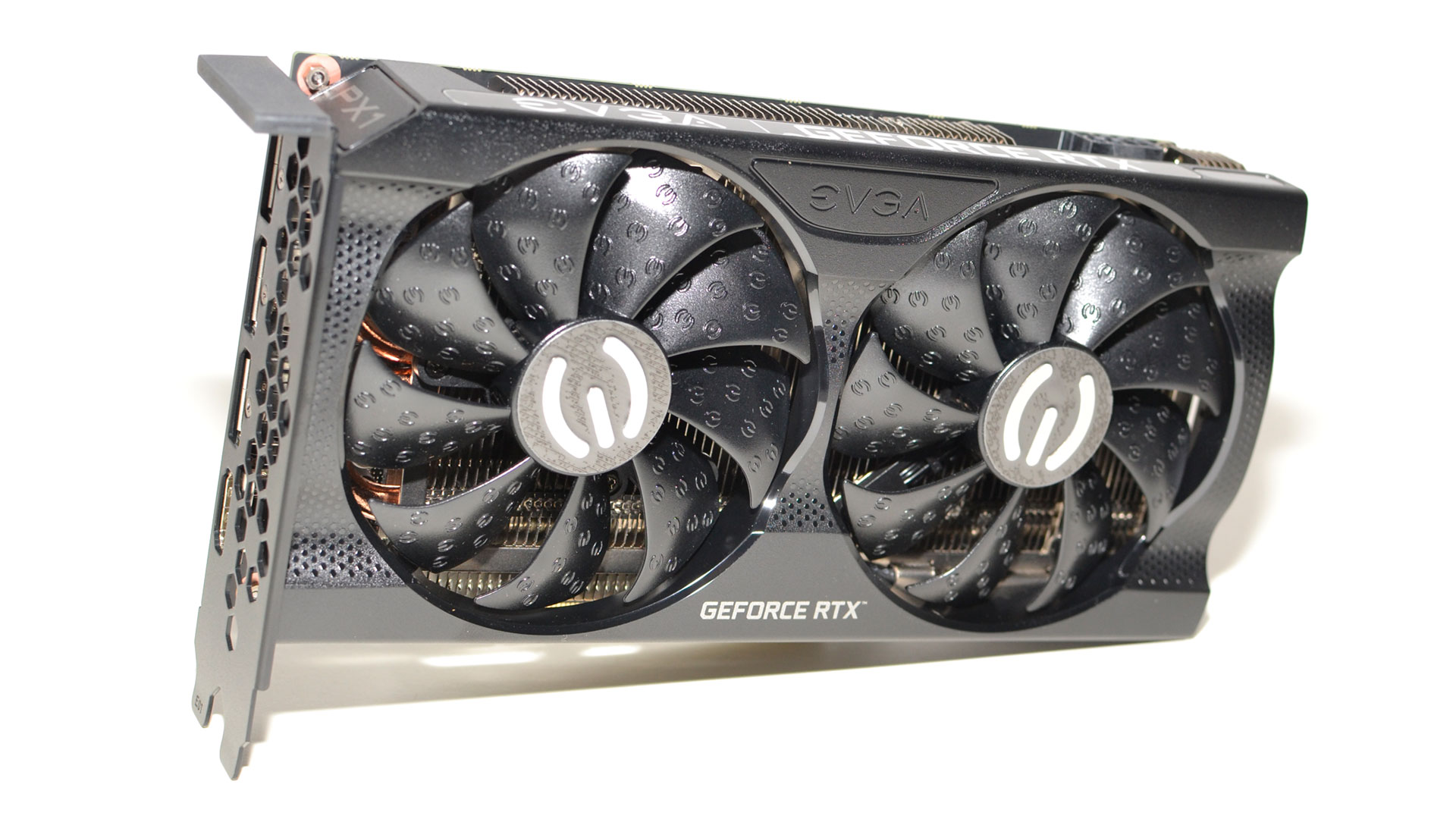
Equally we approach the lowest terminate of the price and performance ladder with Nvidia's desktop Ampere lineup, the cuts to processing power may have gone too far. This is the first GA106 card, with a 192-scrap memory interface and 12GB VRAM, which is quite a chip better than the RTX 3050 just still a big step downwards from GA104. With 26% fewer GPU cores compared to the 3060 Ti, and less retentiveness bandwidth, overall performance is only on the level of the RTX 2070.
And so, two and a one-half years later, you tin now match a $500 graphics card with a $330 alternative. Unfortunately, demand still surpasses supply, and the cheapest RTX 3060 cards typically go for effectually $400. Still, given the performance we saw in our testing, the RTX 3060 delivers a smashing overall value, factoring in ray tracing and DLSS functioning.
VRAM capacity isn't a problem, and there are a few instances where the 3060 starts to shut the gap with the 3060 Ti. It never quite gets at that place, however, and the 3060 Ti may exist the meliorate choice if you lot can find i at a reasonable price. At present, it's a $125 jump to the 3060 Ti, making this or one of AMD'due south offerings a much meliorate value.
On the other manus, discounting ray tracing and DLSS, in our testing the RTX 3060 ends upwardly beingness roughly the same performance as AMD's RX 5700 XT, 18 months afterward. Not exactly something to set the globe on burn down, but then that's typical of mainstream parts. With DXR and DLSS, nonetheless, the 3060 tin even merchandise blows with AMD'due south RX 6800.
Read:
Nvidia GeForce RTX 3060 Review (opens in new tab) 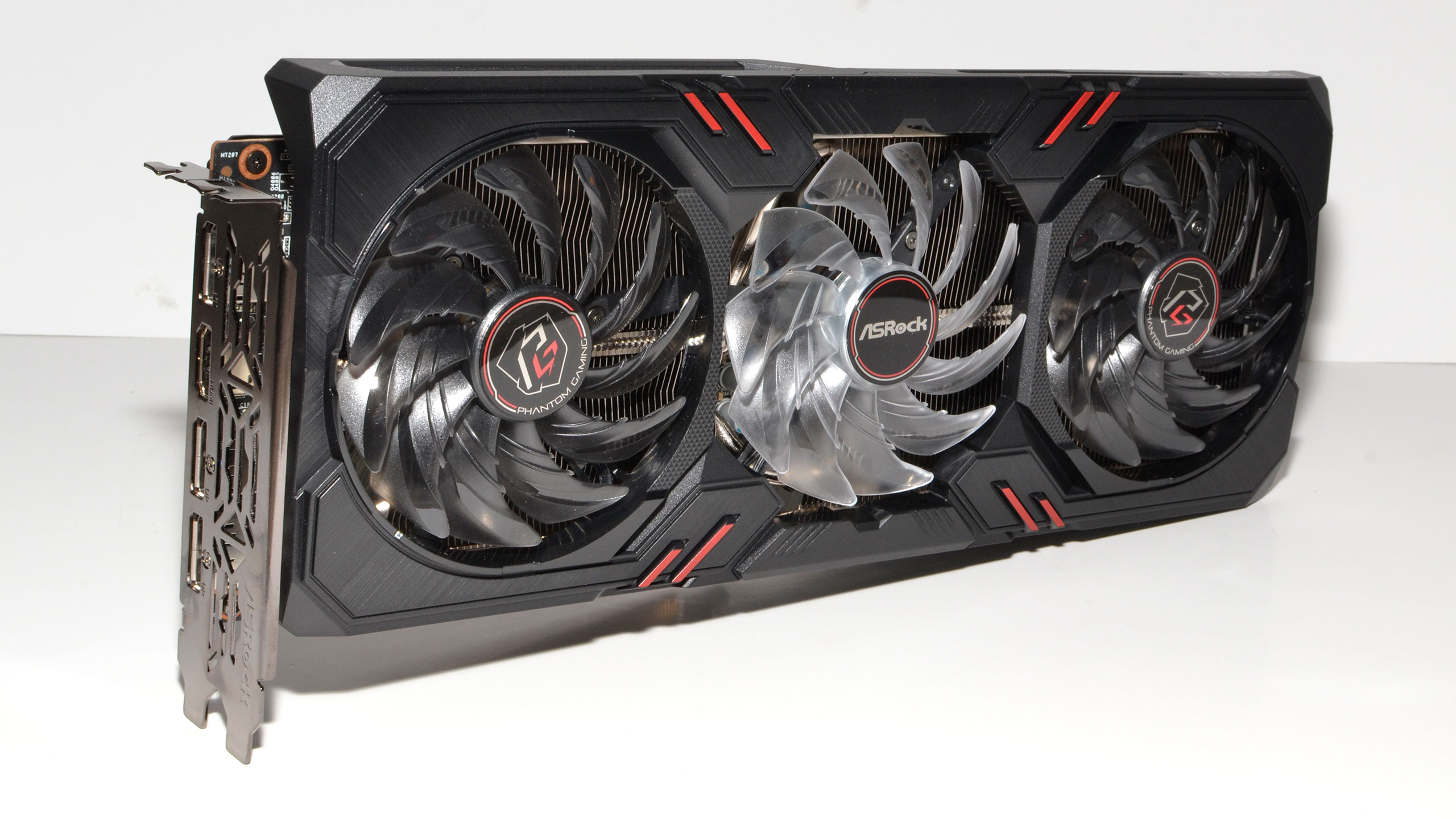
AMD'south reply to the RTX 3060, sort of, comes via the Navi 23 compages. Normally, nosotros'd wait a 32 CU variant of Navi 22, dubbed the RX 6700 not-XT, but AMD trimmed CU counts, memory interface width, and Infinity Cache sizes to get a smaller and less expensive fleck that still performs well. (Note that the Radeon RX 6700 now evidently exists, with 10GB of VRAM.)
Performance ends up slightly above the previous gen RX 5700 XT, which is impressive considering the retentiveness autobus has been cut in half to just 128 bits. There'due south understandable business concern with the 8GB of VRAM, however, and there are certainly cases where the RTX 3060 ends upward as the meliorate choice. Still, it'due south surprising how much even a 32MB Infinity Cache seems to heave operation, when you lot look at the retentivity bandwidth. This is basically a flake that'due south smaller than Navi 10, congenital on the aforementioned TSMC N7 node, and it delivers ten–xv% better framerates at 1080p.
There are instances where it struggles, however, ray tracing being a big 1. Several games that we tested with DXR (DirectX Raytracing) back up couldn't fifty-fifty do twenty fps at 1080p. Nvidia's RTX 3060 was about twice every bit fast, without using DLSS, and typically over l% faster with DLSS Quality mode. FSR doesn't really fix that, either, since it provides a similar boost in operation to both AMD and Nvidia — and fifty-fifty Intel — GPUs. Subsequently delivering impressive amounts of VRAM on the other Big Navi chips, the RX 6600 XT feels like a letdown.
The $379 starting point for a GPU that's ostensibly a replacement to the previous generation RX 5600 XT ($279 launch toll) doesn't garner whatsoever goodwill. However, in these days of overpriced graphics cards, y'all tin can now detect the Radeon RX 6600 XT starting at $350! The new Radeon RX 6650 XT just provides a pocket-size v% bump in functioning coupled to a xiv% bump in price, and so we'd give that a pass for now.
Read:
AMD Radeon RX 6600 XT Review 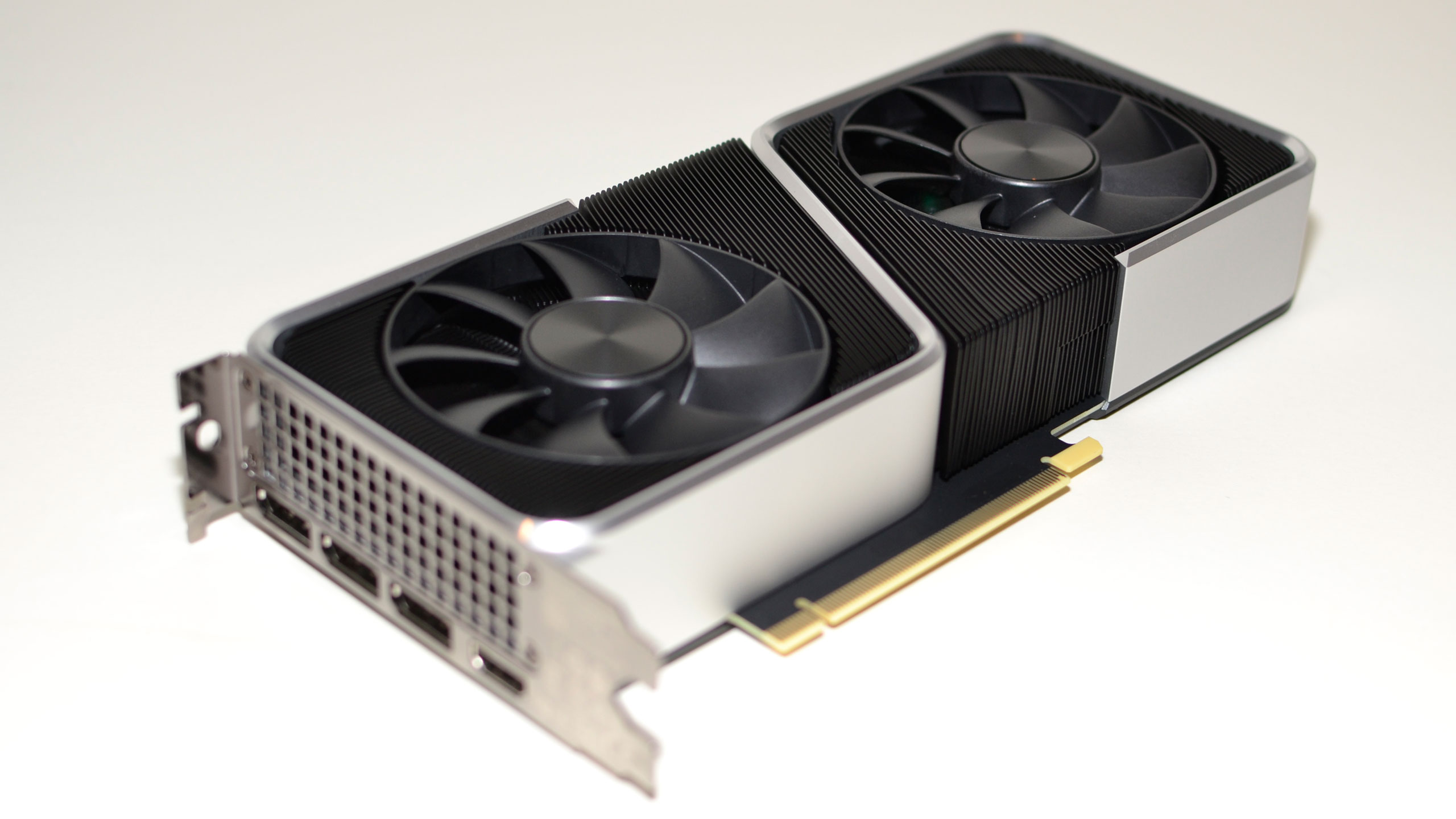
When we tested the GeForce RTX 3060 Ti, we felt it might be the best of the bunch for Nvidia'southward Ampere GPUs. It has withal features as the other thirty-serial GPUs, with a starting price of just $399. In theory, of form, as it naturally sold out just every bit quickly as all the other new graphics cards. Thing take improved, nonetheless, and the lowest price we can discover right now is downwards to around $525 — which is withal $125 more MSRP. <Sigh>
The 3060 Ti vanquish the previous gen 2080 Super in our testing, winning in every game nosotros ran. Information technology's also only about ix percent slower than the RTX 3070 but costs twenty percent less. If you're still sitting on an older GTX 1070 or RX Vega 56, the 3060 Ti is up to twice equally fast — sometimes fifty-fifty more, in the latest games.
The only real concern is the lack of VRAM. 8GB is mostly plenty, for now, just some games are starting to push beyond that threshold. Of class y'all can drop the texture quality a notch, and you lot might non even discover the deviation, but deep down inside you'll feel regret. (Not really — high settings often look indistinguishable from ultra settings.)
AMD's RX 6600 and RX 6600 XT give the 3060 Ti some stiff contest, yet. Nvidia's role is still faster, particularly in ray tracing games, but the RX 6600 XT currently sells for virtually $175 less than the 3060 Ti, and the RX 6600 drops prices below the $300 barrier.
Read:
Nvidia GeForce RTX 3060 Ti Review (opens in new tab) 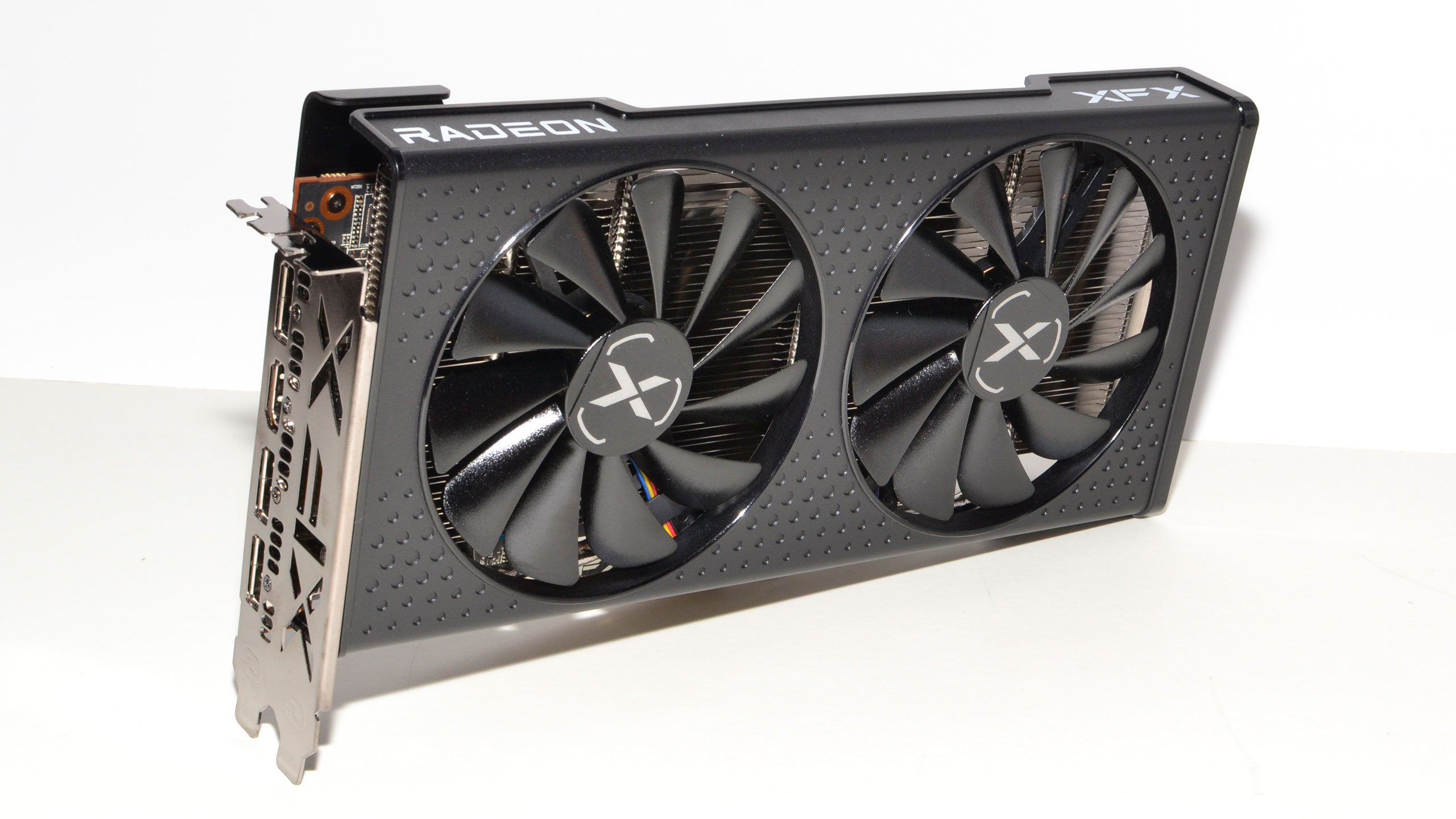
The Radeon RX 6600 takes everything good about the 6600 XT and and then scales it back slightly. Information technology'southward near xv% slower overall, just a flake backside the RTX 3060 as well, but in our testing it was withal 30% faster than the RTX 3050. Nosotros're also seeing the cards in stock and on sale, starting at $290 for this Sapphire RX 6600 Pulse (opens in new tab) (afterwards $20 rebate).
That's quite a bit less than AMD'due south official $329 MSRP, which felt somewhat high at launch — not that we e'er saw those prices in meaningful quantities until recently. But with cards shipping at or below MSRP, this represents the market's all-time overall blindside for the cadet.
Upkeep to midrange graphics cards are a competitive arena, and the RX 6600 has to compete against both the new RTX thirty-serial too every bit the previous generation RTX 20-series. It ended up delivering near-RTX 2070 performance, at least in non-ray tracing scenarios. With ray tracing enabled, however, it struggled badly, barely averaging 30 fps in our DXR examination suite at 1080p medium.
If yous're not worried about ray tracing, the RX 6600 definitely warrants a wait. AMD'due south Infinity Enshroud does wonders for what otherwise looks like a somewhat underpowered GPU, and the card only needs almost 130W, far less than competing GPUs.
Read: AMD Radeon RX 6600 Review
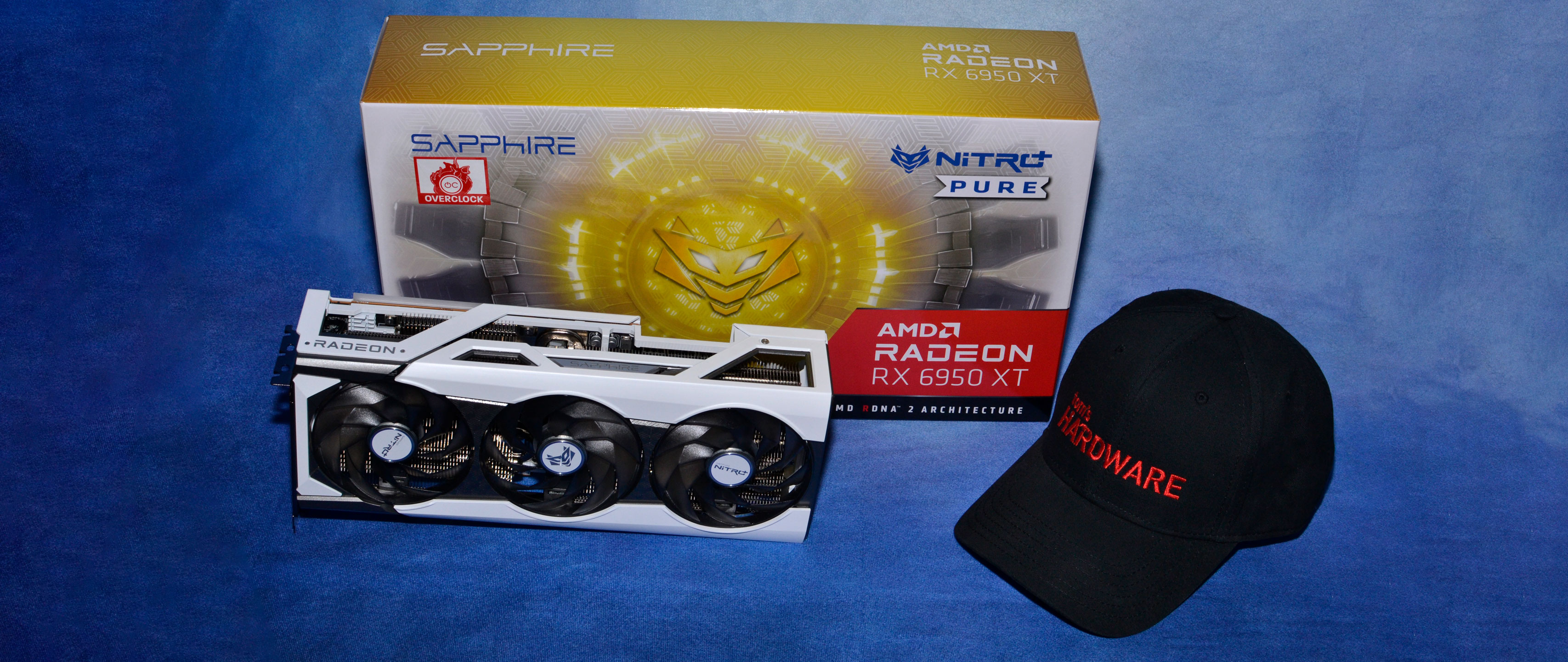
The RX 6950 XT currently represents the ultimate performance from the RDNA2 architecture, surpassing the onetime RX 6900 XT by about 9% on average. AMD set the MSRP at a rather high $1,099 at launch, but we're already seeing cards selling below that marker. The RX 6950 and 6900 XT are basically the aforementioned GPU, simply with faster 18Gbps GDDR6 on the 6950 forth with a higher power limit and slightly higher GPU clocks.
The RX 6950 XT boasts slightly more GPU cores than the RX 6800 XT, and combined with the difference in clock speeds the 6950 XT is nigh 15% faster overall. However, the 6950 XT costs virtually twoscore% more, while the 6900 XT goes for virtually $200 less, so opting for AMD'due south penultimate GPU over the peak card isn't a terrible thought.
In terms of standard gaming performance, the RX 6950 XT ranks equally the fastest GPU around at 1080p and 1440p, but falls backside at 4K. The usual caveats virtually lower ray tracing performance and the lack of DLSS support employ as well, and while FSR ii.0 looks good, it's not widely supported by games withal whereas over 200 games and applications have already adopted DLSS. If you desire the all-time DXR/RT feel correct now, Nvidia still wins — not that you demand ray tracing to bask games.
Those who just want the fastest AMD GPU will notice enough to like with the 6950 XT. It'south non a revolution compared to the existing RX 6900 XT, but we didn't await information technology to exist. The bigger concern is the upcoming RDNA 3 GPU launch, which should happen before the end of 2022. Early on rumors might be fantasy land, but in general we'd expect a forty–fifty% improvement in performance compared to the existing GPUs. Waiting another six months (or less) to see how things turn out makes a lot more sense than upgrading to the 6950 XT at this late phase in the RDNA 2 life cycle.
Read: AMD Radeon RX 6950 XT review (opens in new tab)
AMD Radeon RX 6900 XT review (opens in new tab)
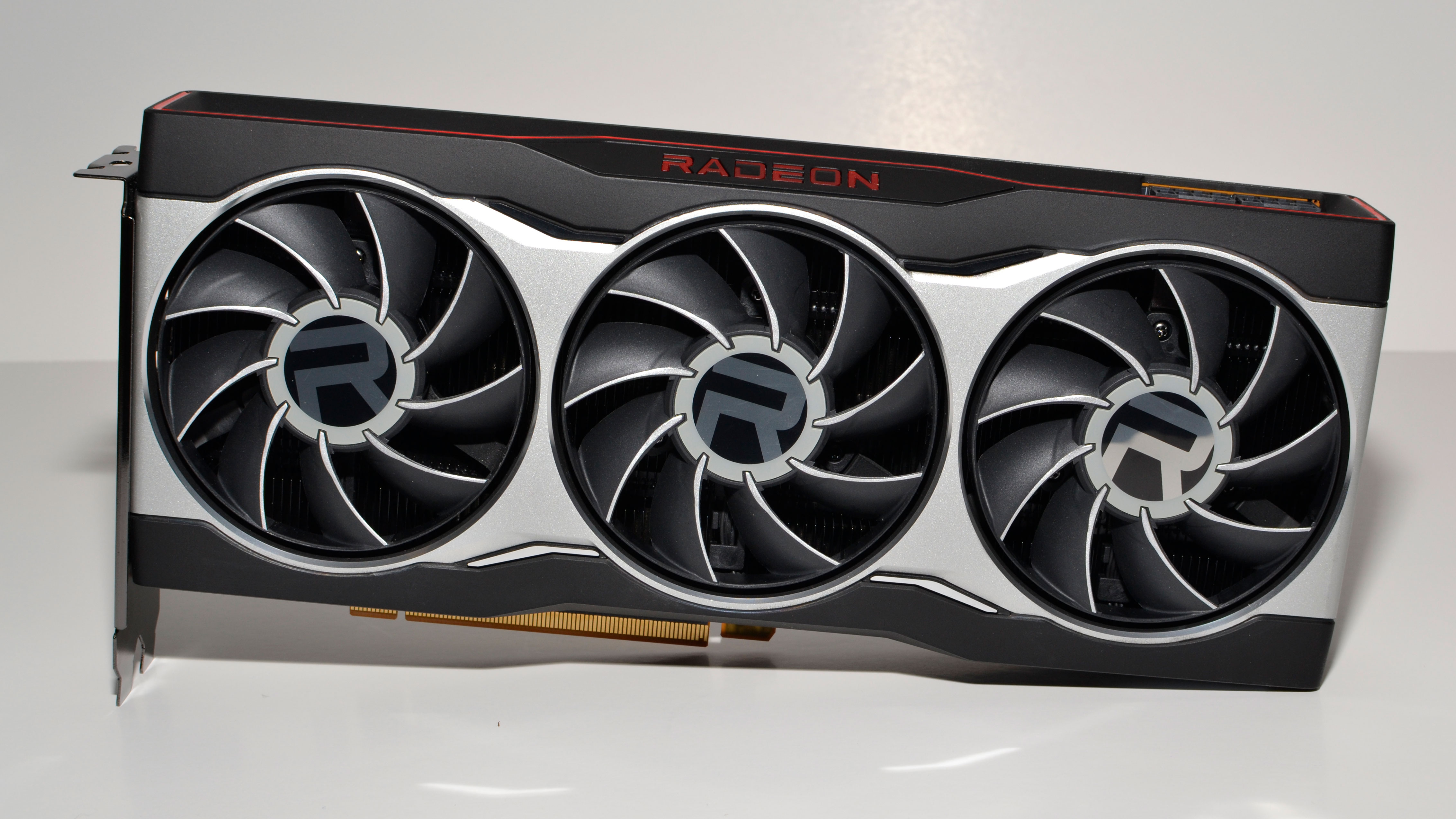
Take everything great about the Navi 21 GPU that powers the 6800 XT, then trim information technology by nearly 10–15% and you lot go the vanilla RX 6800. You however get the full 16GB GDDR6 and 128MB Infinity Cache, simply but 96 ROPs, fewer GPU cores, and lower clock speeds. It's a reasonable compromise, but nosotros think the 6800 XT is the better option overall.
Right now the RX 6800 starts at $655 online, nigh $120 less than the 6800 XT and a fleck more the RTX 3070 Ti. The RX 6800 puts up a good showing confronting Nvidia's RTX 3070 Ti, winning the non-ray tracing benchmark suite in our testing. However, the Nvidia GPU was 35% faster in our ray tracing benchmarks, non even bookkeeping for the boosted 20–50% DLSS Quality mode tin show.
AMD's FSR 2.0 every bit a DLSS culling could aid long-term, just the current FSR i.0 is more than almost improving performance than epitome quality. Running at a lower resolution, or using Nvidia Image Scaling or AMD RIS will give you lot like performance gains and quality. While FSR 1.0 has been used in over l games, FSR 2.0 is still in its infancy.
We'd grab an RX 6800 more for the rasterization prowess and not worry so much about ray tracing. Simply actually, we'd wait for prices to get downward to reasonable levels, like $600 or less for this particular bill of fare. Hopefully that will happen in the next month or two, simply the future RDNA three and Ada architectures are slated to arrive not long after.
Read: AMD Radeon RX 6800 review (opens in new tab)
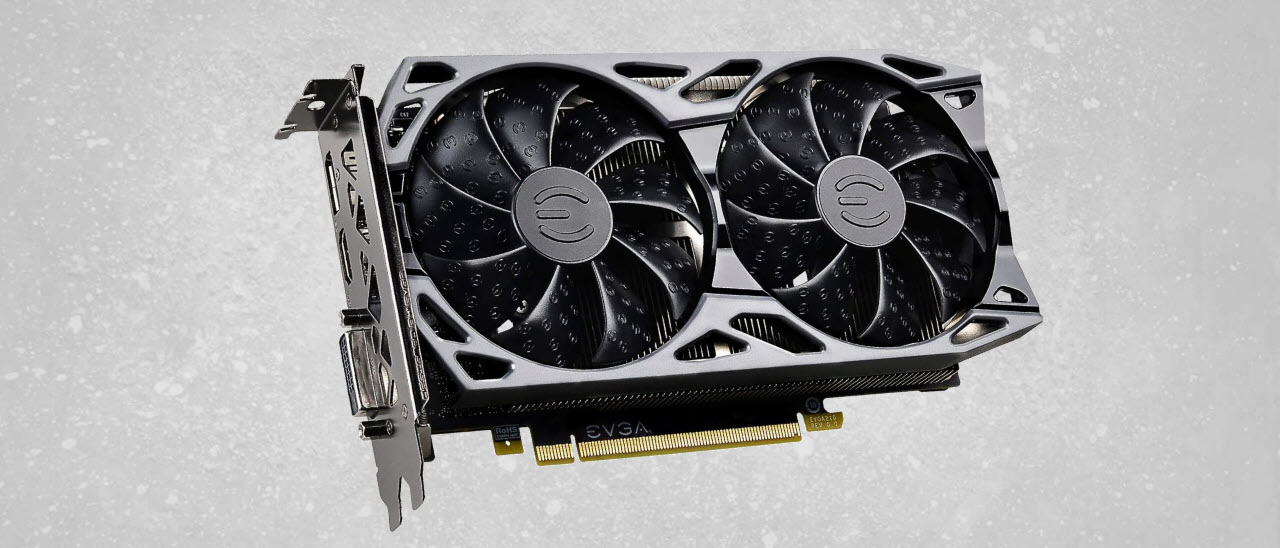
Nvidia tried to create a "upkeep" RTX 30-series carte du jour with its GeForce RTX 3050, though the $250 recommended price still puts it firmly in the mainstream category. It's also selling at $300 or more right now, which is better than the launch prices but not as depression as we'd like to see, because information technology concluded up being 7% slower than the previous generation RTX 2060 in our testing. Still, we'd rather pay for an RTX card than plunk down a similar corporeality of cash for a
GeForce GTX 1660 Super (opens in new tab)or
RX 5500 XT 8GB (opens in new tab)(notation that you can detect meliorate prices for those on eBay if you're willing to purchase a used GPU).
We've done the testing (run into below) and the RTX 3050 was about 15% faster than a GTX 1660 Super, plus it can legitimately run ray tracing games and it too supports DLSS. That's more than than we can say for AMD's RX 6500 XT, which probably should have skipped RT support in substitution for more than VRAM and bandwidth. On the other hand, AMD's RX 6600 (above) was thirty% faster in standard games and simply 13% slower in DXR games, while costing $25 less than the cheapest 3050 we can find right now.
The biggest trouble is that $300 or more is nevertheless a lot to pay for mainstream levels of performance, and nosotros wouldn't be surprised to see prices drop another twenty% or more past the end of the summertime (bold the improving supply doesn't get batty). AMD offers a amend option for those that don't care about ray tracing and DLSS, so this is strictly for people that prefer to stick with Nvidia, fifty-fifty if the operation on tap isn't that compelling.
Read:
Nvidia GeForce RTX 3050 (opens in new tab) 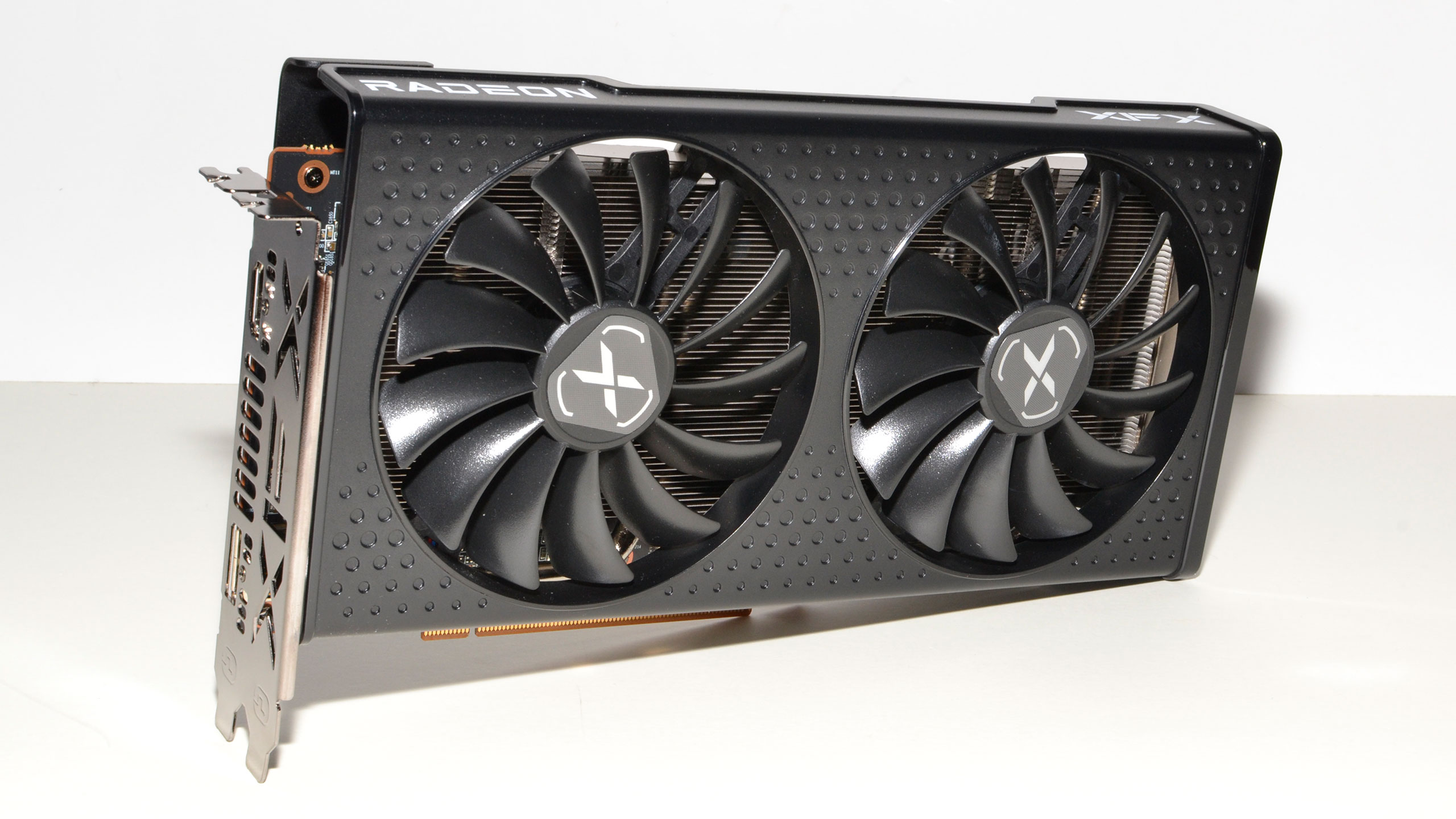
The budget realm of GPUs often ends up going to older hardware, but the Radeon RX 6500 XT at least uses AMD's RDNA 2 GPU. Except, the Navi 24 chips really got cut downwardly on the chopping block, with only a 64-bit memory interface, 16MB Infinity Cache, an x4 PCIe link, older video codec support, and only 2 display outputs. That's a lot of potentially interesting features that got hacked off.
However, if price is your driving business concern, the RX 6500 XT starts at $175, which makes it less expensive than most other options. We'd encourage most gamers to try saving up for the RTX 3050 or RX 6600, equally they're both essentially improve, and performance on the 6500 XT can't quite match the GTX 1650 Super. But right now, the only place to buy a 1650 Super without overpaying is on eBay.
With supplies on previous generation GPUs seemingly not improving, the RX 6500 XT mostly wins our upkeep recommendation by default. We'd much rather accept a GTX 1660 series carte, or even an RX 5500 XT 8GB, but we'd also prefer buying new hardware — buying a used graphics carte represents a risk, with many miners likely offloading cards that have been used hard for the by two years.
Read: AMD Radeon RTX 6500 XT Review
How We Test the Best Graphics Cards
Tom's Hardware 2022 GPU Testbed
Determining pure graphics menu performance is best done by eliminating all other bottlenecks — as much every bit possible, at least. Our 2022 graphics card testbed consists of a Core i9-12900K CPU, MSI Z690 DDR4 motherboard, 32GB Corsair DDR4-3600 CL16 memory, and Crucial P5 Plus 2TB SSD, with a Cooler Principal PSU, case, and CPU cooler.
We exam across the three near common gaming resolutions, 1080p, 1440p, and 4K, using 'medium' and 'ultra' settings. Where possible, we utilise 'reference' cards for all of these tests, like Nvidia's Founders Edition models and AMD's reference designs. Virtually midrange and lower GPUs practise not have reference models, however, and in some cases we only have factory overclocked cards for testing. We do our best to select cards that are close to the reference specs in such cases.
For each graphics card, we follow the same testing procedure. We run one pass of each benchmark to "warm up" the GPU later on launching the game, and so run at least two passes at each setting/resolution combination. If the two runs are basically identical (within 0.5% or less deviation), we employ the faster of the two runs. If there's more than a small deviation, we run the test at to the lowest degree twice more to decide what "normal" operation is supposed to be.
We also wait at all the data and cheque for anomalies, so for example RTX 3070 Ti, RTX 3070, and RTX 3060 Ti all generally going to perform inside a narrow range — 3070 Ti is virtually 5% faster than 3070, which is about five% faster than 3060 Ti. If we see games where in that location are clear outliers (i.due east. performance is more x% higher for the cards just mentioned), we'll go back and retest any cards are showing the anomaly and effigy out what the "right" upshot would be.
Due to the length of time required for testing each GPU, updated drivers and game patches inevitably come out that can impact performance. We periodically retest a few sample cards to verify our results are nonetheless valid, and if non, nosotros become through and retest the affected game(s) and GPU(s). Nosotros may also add games to our test suite over the coming year, if one comes out that is popular and conducive to testing — run across our what makes a expert game benchmark for our option criteria.
Choosing Among the All-time Graphics Cards
We've provided a dozen options for the best graphics cards, recognizing that there'southward enough of potential overlap. The latest generation GPUs consist of Nvidia's Ampere architecture cards and AMD'due south RDNA2 architecture offerings, and the Intel Arc Alchemist GPUs should arrive in the side by side couple of months. Conveniently, Arc Alchemist, RDNA2, and Ampere all support the same general features (DirectX 12 Ultimate and ray tracing), though Arc and RTX cards also take additional tensor core hardware.
We've listed the best graphics cards that are bachelor correct now, forth with their electric current online prices, which we track in our GPU prices guide. With many cards now just costing 25% more than MSRP, plenty of people seem ready to upgrade, and supply also looks to be improving. Whether that will continue until the next-gen GPUs go far remains to be seen.
Our communication: Don't pay more today for yesterday'due south hardware. If y'all desire an RTX xxx-serial or RX 6000-series graphics card, exist patient and you'll eventually be able to buy one at close to the official MSRP. At this point, you might just give Ampere and RDNA2 a pass and await for Ada and RDNA3.
If your main goal is gaming, you tin't forget about the CPU. Getting the best possible gaming GPU won't assist you much if your CPU is underpowered and/or out of appointment. So be sure to bank check out the Best CPUs for Gaming page, also as our CPU Benchmark hierarchy to brand certain you lot have the right CPU for the level of gaming you're looking to attain.
Our current recommendations reflect the changing GPU market, factoring in all of the above details. The GPUs are ordered using subjective rankings, taking into business relationship performance, price, features, and efficiency, so slightly slower cards may cease upward higher on our list.
When ownership a graphics card, consider the following:
• Resolution: The more than pixels you're pushing, the more performance you need. You don't need a top-of-the-line GPU to game at 1080p.
• PSU: Make certain that your power supply has plenty juice and the correct 6- and/or 8-pin connector(s). For example, Nvidia recommends a 550-watt PSU for the RTX 3060, and yous'll need at least an 8-pivot connector and possibly a half-dozen-pin PEG connector also.
• Video Memory: A 4GB carte is the minimum correct now, 6GB models are amend, and 8GB or more than is strongly recommended. A few games can at present use 12GB of VRAM, though they're the exception rather than the rule.
• FreeSync or G-Sync? Either variable refresh rate technology volition synchronize your GPU's frame rate with your screen's refresh rate. Nvidia supports G-Sync and Thousand-Sync Compatible displays (for recommendations, run across our Best Gaming Monitors list), while AMD's FreeSync tech works with Radeon cards.
• Ray Tracing, DLSS, and FSR: The latest graphics cards support ray tracing, which can be used to enhance the visuals. DLSS provides intelligent upscaling and anti-aliasing to boost functioning with similar image quality, but it'due south but on Nvidia RTX cards. AMD'south FSR works on virtually any GPU and besides provides upscaling and enhancement, but on a different subset of games.
Graphics Cards Performance Results
Our current test suite of games consists of 8 titles. The data in the following charts is from testing conducted during the by several months. Only the fastest cards are tested at 1440p and 4K, simply we do our best to exam everything at 1080p medium and ultra.
AMD's FSR has now been out for almost a year now, with FSR 2.0 having just launched. Nvidia's DLSS in contrast has been around for a few years and has decent uptake. None of the games in our cadre suite of benchmarks support FSR, and so we're running at native resolution for all of these tests. We take a separate commodity looking at FSR and DLSS, and the bottom line is that DLSS improves functioning with less compromise to epitome quality, only FSR works on whatever GPU. The newer FSR ii.0 does a lot to bridge the gap, only DLSS has a big lead in game support.
The charts beneath contain all the current generation RTX xxx-series and RX 6000-series, plus previous generation GPUs where applicable (meaning, non-RT cards can't run our DXR benchmarks). Our GPU benchmarks bureaucracy contains additional results for those who are interested, along with functioning testing from our 2020-2021 suite running on a Core i9-9900K. The charts are colour coded with AMD in red/grey and Nvidia in blue/black to brand it easier to come across what's going on.
The following charts are up to appointment every bit of June 1, 2022. All electric current generation and previous generation GPUs are included.
Best Graphics Cards — 1080p Medium
Best Graphics Cards — 1080p Ultra
Best Graphics Cards — 1440p Ultra
Best Graphics Cards — 4K Ultra
Best Graphics Cards — Ability Consumption
Besides performance, nosotros likewise examination graphics card power consumption, clock speeds, fan speeds, and temperatures. We tested all current GPUs using Powenetics equipment and software, and while Nvidia generally had an efficiency lead on previous generation parts, AMD's RDNA2 GPUs now rate as the near efficient options in most cases. Here are the charts from our testing.
Finding Discounts on the Best Graphics Cards
With all the GPU shortages these days, you're unlikely to see huge sales on a graphics carte, but you may observe some savings by checking out the latest Newegg promo codes, Best Buy promo codes and Micro Center coupon codes.
Want to comment on our best graphics picks for gaming? Allow u.s. know what you recollect in the Tom's Hardware Forums.
More: HDMI vs. DisplayPort: Which Is Ameliorate For Gaming?
MORE: All-time CPUs for Gaming
What's The Best Gtx Card,
Source: https://www.tomshardware.com/reviews/best-gpus,4380.html
Posted by: williamsmideed41.blogspot.com


0 Response to "What's The Best Gtx Card"
Post a Comment